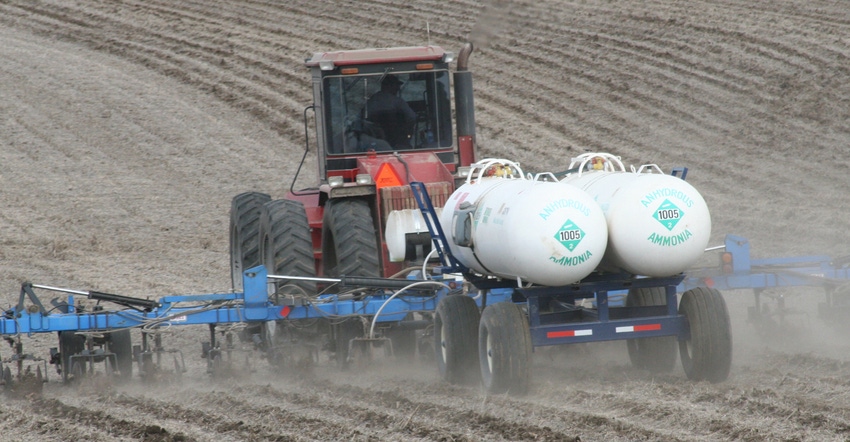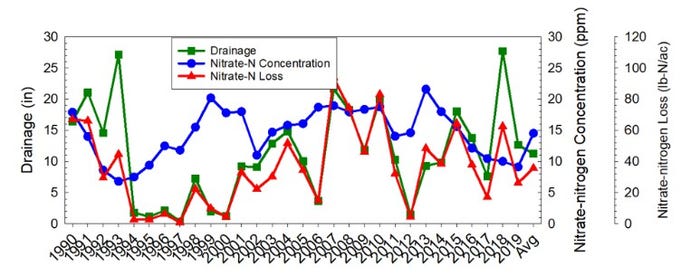October 26, 2020

In an Iowa Learning Farms webinar Sept. 1, Matt Helmers, director of the Iowa Nutrient Research Center at Iowa State University, presented nitrogen management research conducted on farms across three decades. In the webinar, “Long-Term Impacts of 4R Nitrogen Management Practices and Cover Crops on Nitrate-N Loss,” Helmers discussed the benefits of different nitrogen applications and management practices on reducing nitrate-N concentration in water leaving fields, as well as comparative crop yield advantages.
The 4Rs of nitrogen management are right source, right rate, right time and right place. Of these, rate and time — or timing of nitrogen application — are the main contributors to managing nitrate-N losses through drainage systems, thereby having the greatest impact on water quality.
As a general rule, Helmers suggests applying nitrogen as near in time to when it will be used by crops will have the greatest positive impact on nitrate-N losses. In reviewing the data from four study sites, Helmers drew some parallels in nitrogen application and uptake in relation to application timing. In addition, he suggested farmers pay close attention to planning for spring crops.
“We are coming off a very dry year when many areas of Iowa suffered drought conditions that most likely slowed the utilization of nitrogen applied to the fields,” he said. “Crops in a drought year don’t use as much nitrogen as they would in a normal year. In looking back at the nitrate-N concentrations in drainage water in 2013, immediately following a drought-stricken 2012, we can expect similar high nitrate-N losses next spring in 2021 unless careful planning and mitigation practices are implemented now.”
The ISU studies all measure nitrate-N concentrations in drainage water through a flow monitoring system that gathers a flow proportional water sample for analysis of nutrients.
Lessons from 30 years of data
The Gilmore City Drainage Research Facility has been under continuous monitoring for nitrate-N concentration in drainage water for 30 years. Throughout the study, one system had nitrogen application and management consistent with an early-spring sidedress application at 150 to 160 pounds of N per acre to corn in a corn-soybean rotation. Analysis of this valuable cache of data indicates that weather is a major factor in impacting year-to-year variability nitrate-N concentration.
Years following particularly wet growing seasons show low nitrate-N levels in drainage water, and conversely, years following dry seasons have significantly higher nitrate-N losses.
 30-year summary: Years following wet growing seasons show low nitrate-N levels in drainage water; years following dry seasons have significantly higher N losses at ISU’s Gilmore City Drainage Research Facilities.
30-year summary: Years following wet growing seasons show low nitrate-N levels in drainage water; years following dry seasons have significantly higher N losses at ISU’s Gilmore City Drainage Research Facilities.
“These data support a clear argument for actively implementing mitigation this fall and before 2021 planting,” Helmers said. “We have an opportunity to manage application rates and mitigate losses in the spring by accounting for high residual nitrogen levels caused by drought conditions. I recommend producers consult with their agronomist and service provider to determine appropriate application rates.”
A different data set from Gilmore City shows the relation of nitrogen application rates to nitrate-N losses over a 15-year period. Helmers noted that as expected, losses increased as application rates increased, but when they exceeded 150 pounds N per acre, the curve accelerated, indicating higher loss levels.
Application timing
Studies at ISU’s Northwest Research Farm (NWRF) and the Northeast Research Farm (NERF) tracked different nitrogen application practices from 2015 through 2019.
The NWRF study compared crop yields and nitrate-N losses with fall, spring, split and no nitrogen application methods. In four of five years, all methods where nitrogen was applied showed no significant difference in corn yields. However, in 2017 very little rain fell after the second application in the split method trial, and yields were somewhat lower than the fall or spring application groups.
Helmers noted that when looking at the combined data, long-term trends are emerging which indicate significantly lower nitrate-N concentrations in the drainage water with the split and no nitrogen methods. “This is encouraging news in thinking about the 4Rs,” he said. “The timing of nitrogen application using the split method is showing the potential for improvement in nitrate-N concentration compared to fall or spring application timing.”
The NERF study addressed different liquid swine manure application timing, with and without cereal rye cover crops, from 2016 through 2019.
Nitrate-N concentrations were highest with early application of liquid swine manure — immediately following harvest — but were substantially reduced when cover crops were planted following application. Late fall application of manure provided better nitrate-N concentration results specifically in the corn year, but the rates were still higher than the early application plus cover crop combination.
“We can safely conclude that the cover crops are helping hold the nitrogen thereby reducing loss to the watershed,” Helmers said. “The other interesting part of this study was the production impact we measured with the different manure timing.”
Looking at corn production in this study, late-fall manure application resulted in increases as high as 40 bushels per acre versus early fall application.
Key takeaways
In closing the webinar, Helmers highlighted the following key points:
Split application of nitrogen is showing trends for reduced nitrate-N concentrations when compared to spring and fall applications.
Early fall manure application increases risk of nitrate-N loss and may reduce corn production.
Cover crops after early fall manure application reduce risk of nitrate-N loss.
Cover crops can reduce nitrate-N loss, particularly following a drought.
“2020 is reminiscent of 2012 when there were similar drought conditions,” Helmers said. “Having the opportunity to look at nitrate-N loss data for 2013, we can make some estimations of what to expect in 2021. This fall, if possible or viable on their farm, we strongly encourage folks to consider planting cover crops to take up some of the residual nitrogen in the soil. I understand that we will still need moisture to aid cover crop establishment, but if we are successful it will tie up some of the nitrogen in the soil and reduce losses to the watershed.”
To view the webinar and get all the details of these nitrogen management studies, visit Iowa Learning Farms.
Ripley is an Iowa Learning Farms conservation outreach specialist.
About the Author(s)
You May Also Like




